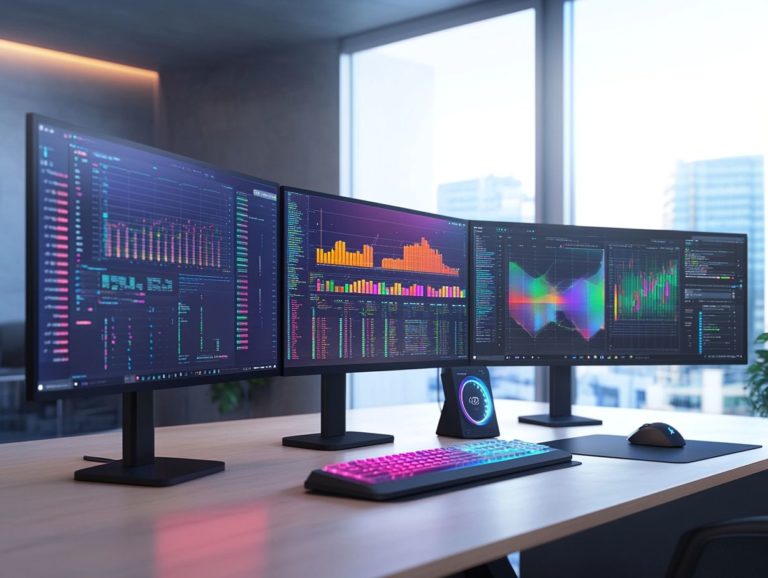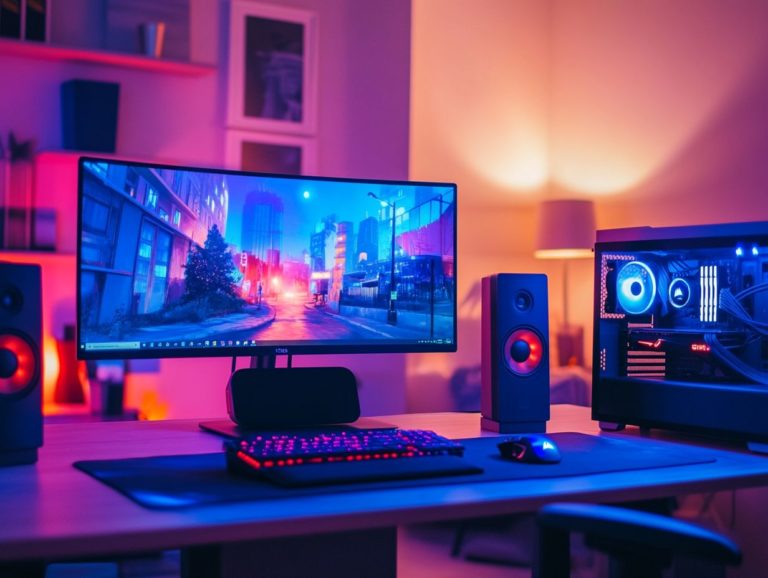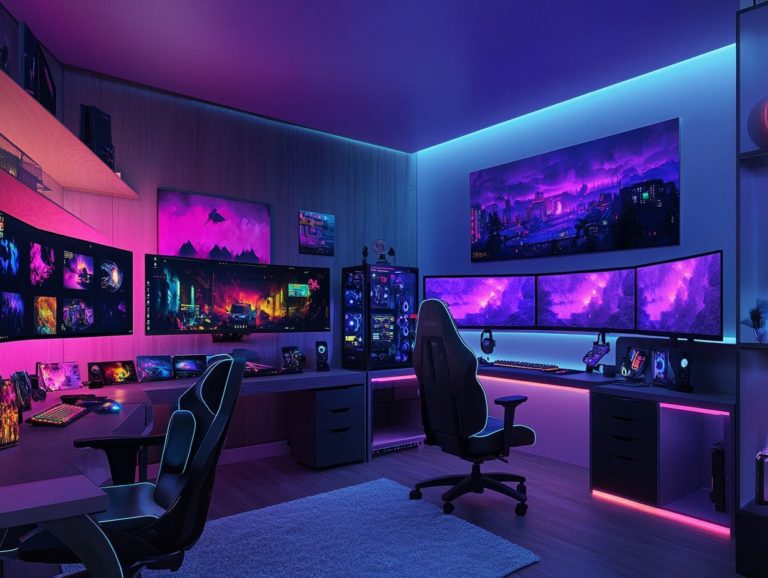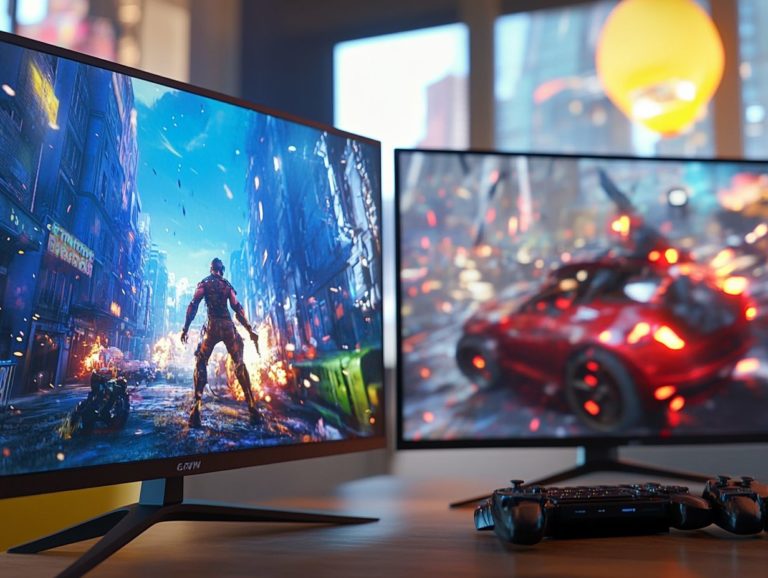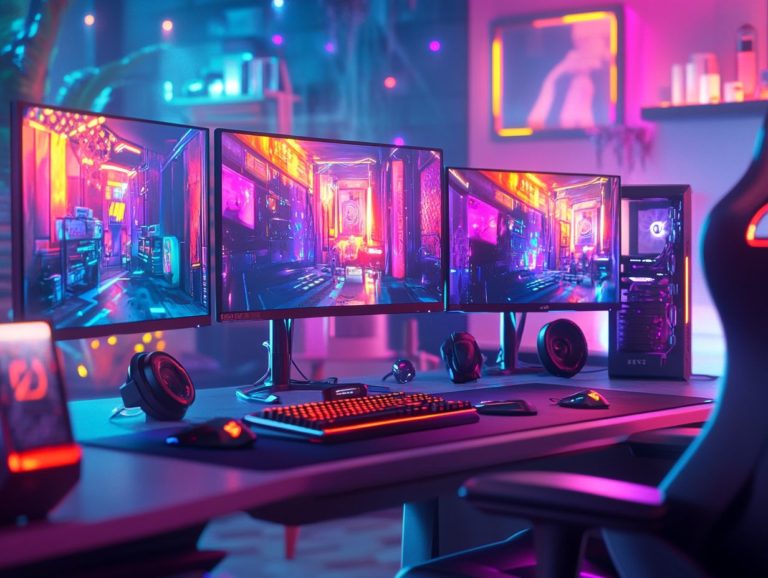the ultimate guide to gaming monitor sizes
Choosing the right gaming monitor elevates your gaming experience. With so many options available, it’s easy to feel overwhelmed.
This guide helps you understand monitor sizes, their meanings, and key factors like resolution, refresh rates, and aspect ratios.
Whether you’re leaning toward a sleek 24-inch model or a commanding 32-inch display, this guide assists you in determining what suits your gaming setup and personal preferences best.
Prepare to enhance your gaming journey with the perfect monitor size!
Contents
- Key Takeaways:
- Understanding Monitor Sizes
- Factors to Consider When Choosing a Gaming Monitor Size
- Popular Gaming Monitor Sizes and Their Uses
- Finding Your Perfect Monitor Size
- Tips for Maximizing Your Gaming Experience with Monitor Size
- Frequently Asked Questions
- What are the benefits of using a gaming monitor?
- What is the ideal size for a gaming monitor?
- How does the screen resolution affect gaming performance?
- What is the difference between a curved and flat gaming monitor?
- Can I use a TV as a gaming monitor?
- What features should I look for in a gaming monitor?
Key Takeaways:
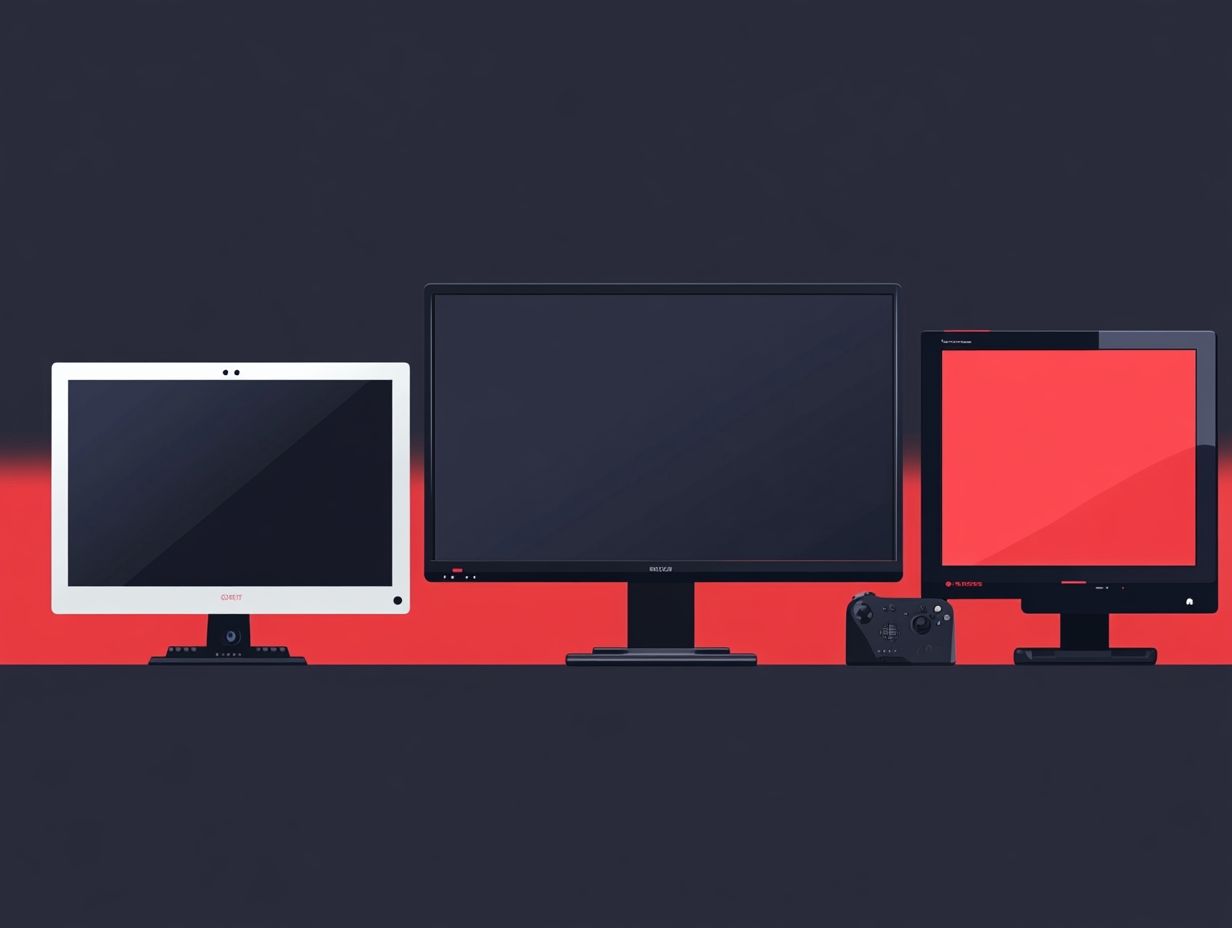
- Monitor sizes are measured diagonally in inches.
- Consider resolution, aspect ratio, refresh rate, and response time when choosing a monitor.
- 24-inch monitors are ideal for competitive gaming, 27-inch for immersive play, and 32-inch for a cinematic feel.
Understanding Monitor Sizes
Understanding monitor sizes is essential for gamers looking to enhance their experience. The right display can significantly impact both immersion and performance.
Monitor sizes range from compact 24-inch options to impressive 32-inch screens. Each offers distinct advantages and specific scenarios where they excel.
When considering display size, it’s not just about physical dimensions; it also involves resolution, refresh rates, and gaming specifications that fit your budget and preferences.
Features like HDMI 2.1 and HDR support are crucial for good visuals. Understanding these specifications helps you make the best choice for your gaming setup.
What Do the Numbers Mean?
The specifications associated with monitors, such as resolution and aspect ratios, reveal a lot about their visual capabilities and suitability for gaming.
For instance, the 16:9 aspect ratio is the gold standard for most gaming monitors, while ultrawide displays often feature a 21:9 aspect ratio, enhancing your immersive experience.
Pixel density is another important metric that affects image quality. Higher resolutions like 1440p or 4K provide sharper images compared to standard HD.
Higher pixel density reduces the visibility of individual pixels, resulting in smoother transitions and more detailed textures critical for fast-paced gaming.
Don t overlook the relationship between refresh rate the number of times the screen updates each second and input lag, which is the delay between pressing a button and seeing the action on-screen. Together, these specifications enhance visual fidelity and elevate your overall gameplay.
Factors to Consider When Choosing a Gaming Monitor Size
Selecting the right gaming monitor size involves several key factors that can significantly enhance your setup and experience.
- Refresh rate and input lag are essential specifications; they dictate how responsive and smooth the visuals will be during gameplay.
- Image quality is affected by the monitor’s size and resolution choices, so keep your budget in mind.
- Console compatibility should also be a priority, especially when connecting devices like the Xbox Series X or PlayStation 5, as they require specific features for optimal performance.
Get ready to explore more options and discover the perfect gaming monitor for your needs!
Resolution and Aspect Ratio
Resolution and aspect ratio are crucial elements that shape the visual performance of your gaming monitor. They impact everything from image clarity to overall immersion in the game.
Resolutions such as FHD, QHD, and the increasingly popular 4K offer varying levels of detail. 4K delivers stunning clarity and a vibrant color gamut!
The choice of aspect ratio whether the traditional 16:9 or the cinematic 21:9 enhances your visual experience, especially during immersive gameplay sessions.
Opting for a higher resolution like 4K allows you to appreciate intricate graphical details. This makes game environments feel more lifelike and pulls you deeper into the narrative depth of the stories you explore.
Keep in mind that 4K gaming needs powerful hardware! Not every gamer may have access to this, so evaluate your options. On the flip side, FHD is more accessible but may sacrifice some finer details.
Aspect ratios play a significant role in enhancing your peripheral vision. For example, a 21:9 setup can provide a broader field of view, immersing you even further into the action.
However, not all games are optimized for ultrawide formats, leading to annoying black bars or stretched images.
Thus, finding the right balance between resolution, aspect ratio, and monitor contrast is essential for crafting the most engaging gaming experience possible.
Refresh Rate and Response Time
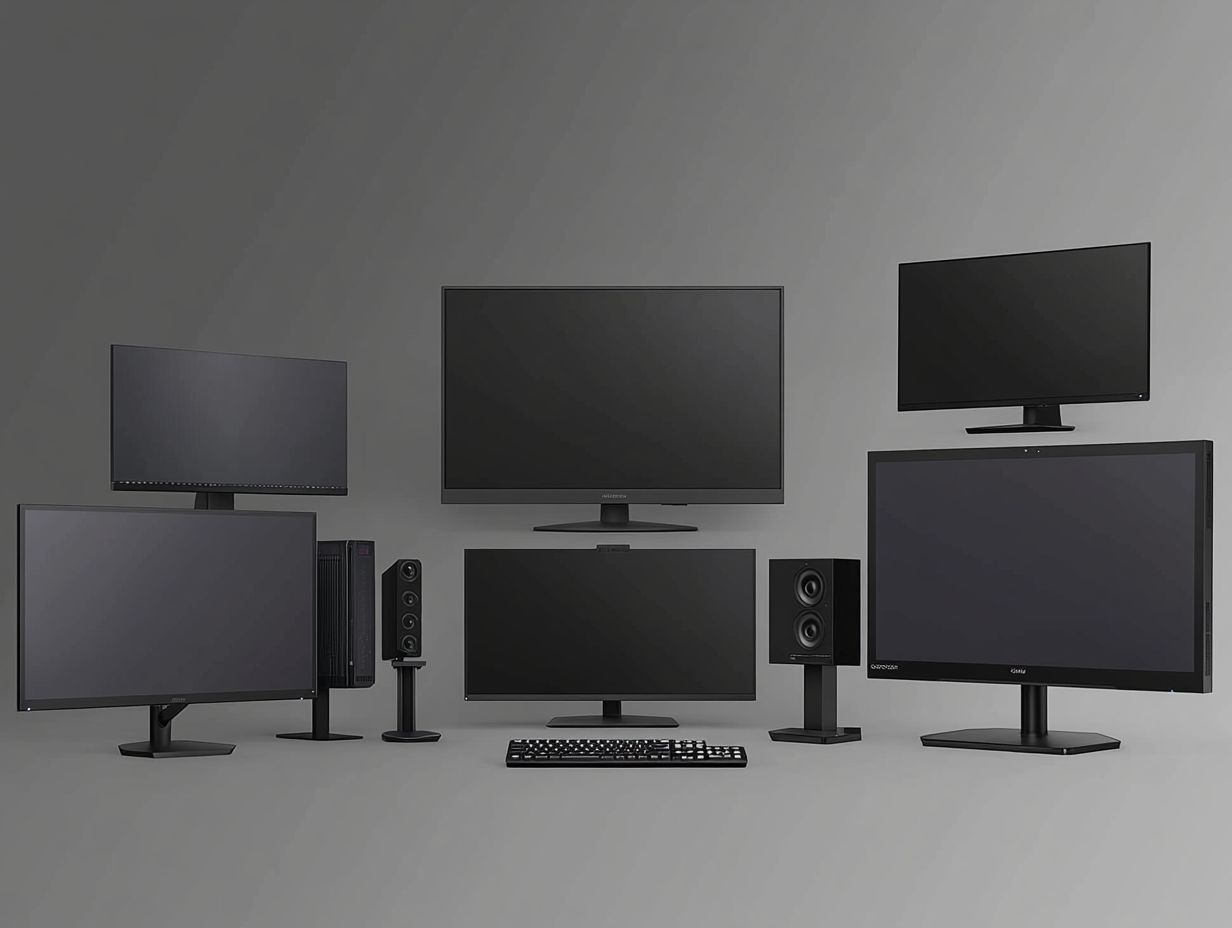
Refresh rate and response time are critical specifications that determine how fluid and responsive your gaming monitor feels. These are essential considerations for any serious gamer!
Choosing a higher refresh rate, such as 144Hz or 240Hz, offers smoother motion and significantly reduces motion blur. Low input lag is equally important, ensuring that on-screen actions respond instantaneously to your commands.
Pixel response time also plays a vital role in preventing ghosting effects, enhancing your overall gaming experience. For competitive gamers, especially those diving into fast-paced action titles or first-person shooters, these specifications are immensely important.
A monitor with a 1ms response time drastically reduces lag and improves clarity, allowing you to react swiftly during intense moments. When choosing a monitor, prioritize features that cater to your favorite genres.
For instance, racing games thrive on higher refresh rates, while strategy games might not demand the same urgency. Striking a balance among these elements ensures an immersive gaming experience that perfectly aligns with your unique playstyle.
Popular Gaming Monitor Sizes and Their Uses
Different gaming monitor sizes cater to your unique gaming preferences and environments. Popular choices include the 24-inch monitor, the 27-inch display, and the larger 32-inch screen.
A 24-inch monitor is ideal for compact gaming setups and casual gaming sessions. It provides a streamlined experience!
If you’re looking for something more balanced, the 27-inch display enhances visual performance, making it a fantastic option for both gaming and productivity.
For those who crave an immersive experience, the 32-inch screen offers a remarkable visual upgrade, especially in a multimonitor setup, allowing you to dive into expansive and dynamic gameplay like never before.
24-inch Monitors
The 24-inch monitor is a fantastic choice if you’re on a budget. It provides a remarkable gaming experience without skimping on essential features!
Despite its compact size, it offers ample resolution options and often boasts impressive refresh rates, making it perfect for casual gaming sessions and even some competitive play.
Plus, its console compatibility means you can easily switch between your gaming laptop and consoles like the Xbox Series X or PlayStation 5.
This size excels at delivering sharp visuals in streamlined setups, allowing you to keep your focus on the action without the distractions of an oversized display.
The smaller screen reduces motion blur, enhancing clarity during fast-paced gameplay. This is ideal for genres like first-person shooters and racing games.
However, the limited screen real estate can feel cramped during immersive gaming experiences or when multitasking. Balancing these advantages and constraints will help you maximize performance while enjoying a comfortable gaming environment.
27-inch Monitors
The 27-inch display is often considered the sweet spot for those seeking an immersive gaming experience. It offers just the right amount of screen real estate for gameplay without overwhelming your setup.
With higher resolution options available, these monitors provide great visuals, making them perfect for both gaming and multimedia consumption. Whether you decide to use it as a standalone display or as part of a multi-monitor arrangement, the 27-inch monitor seamlessly fits into various gaming setups.
Take, for example, popular models like the Dell UltraSharp U2720Q and ASUS ROG Swift PG279Q. They ve earned rave reviews for their color accuracy and refresh rates, significantly enhancing your gaming experience. In fast-paced titles, the crisp visuals and rapid response times help you stay ahead of the competition, ensuring every frame is captured with precision.
Whether you’re nestled in a cozy gaming nook or working in a sprawling home office, this display size integrates beautifully. It appeals to both casual users and hardcore gamers.
You can use a 27-inch monitor for graphic design, video editing, and binge-watching your favorite series. The vibrant detail and expansive view it offers solidify it as an exemplary choice for a variety of needs.
32-inch Monitors
The 32-inch screen is an exceptional choice if you crave an ultrawide monitor experience. It delivers expansive visuals that immerse you like never before. This size is ideal for gamers who relish open-world titles and simulations, where a larger field of view can truly elevate your gameplay.
Most 32-inch monitors come with great gaming features, including smooth visuals and better brightness, ensuring you enjoy exceptional picture quality.
With a 32-inch display, you can easily spot enemies lurking in distant corners or navigate vast landscapes with impressive clarity. The larger screen space allows you to manage multiple application windows effortlessly, making it a breeze for streamers to handle their broadcast overlays alongside the game.
Look for models with a 144Hz refresh rate for thrilling, smooth gameplay! Features like FreeSync or G-Sync enhance visual fluidity by synchronizing frame rates between your monitor and graphics card, which is especially advantageous in competitive first-person shooters.
The immersion and detail offered by 32-inch monitors enrich your gaming experience across a variety of genres.
Finding Your Perfect Monitor Size
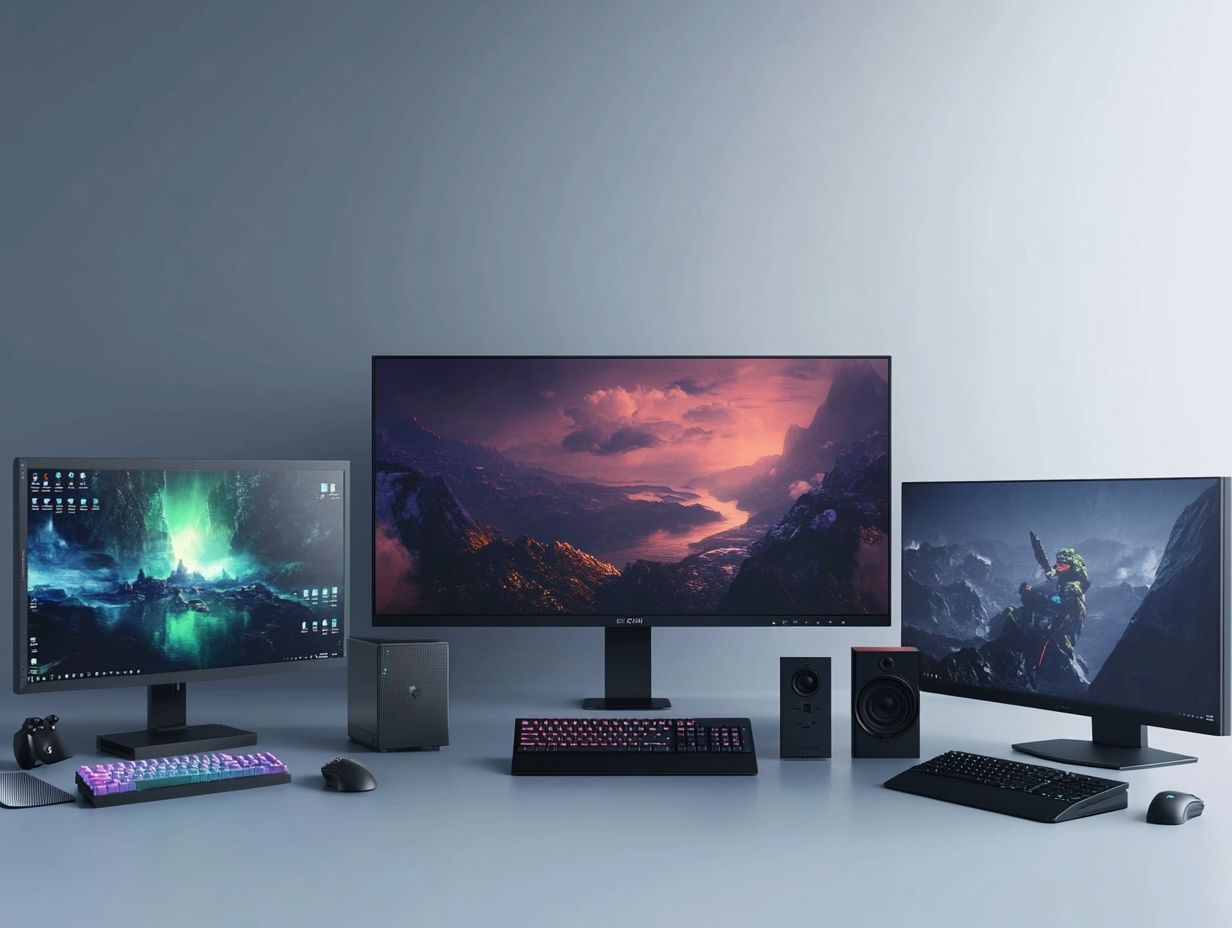
Determining the ideal monitor size for your gaming needs requires careful assessment of your gaming setup and personal preferences. Your choice enhances your overall experience.
Consider factors like your room dimensions, viewing distance, and gaming habits, as these elements significantly influence your decision. It’s essential to think about potential visual upgrades and how effective cable management can elevate both the aesthetics and functionality of your gaming environment, creating a clean and organized space that you can truly enjoy.
Consider Your Gaming Setup and Preferences
Evaluating your gaming setup and preferences is crucial for selecting a monitor size that complements your gaming style. Consider aspects like the layout of your gaming space, compatibility with consoles such as the Xbox Series X and PlayStation 5, and specific monitor features, including refresh rates and HDR support.
By understanding your gaming habits, you’ll be better equipped to determine whether a larger display or a more compact monitor fits your needs best.
If you have a dedicated gaming room with multiple consoles, a 27-inch or larger monitor could provide the immersive visuals you crave, especially for fast-paced games. Conversely, if your setup is on a small desk, a 24-inch model might be ideal, ensuring clear visibility without overcrowding your space.
If you re competitive, you might prioritize monitors with higher refresh rates and adaptive sync technologies. On the flip side, if you enjoy diving into single-player narratives, you may lean toward options that boast superior color accuracy and HDR capabilities.
Each scenario underscores how your individual preferences and physical environment can significantly influence your ultimate monitor choice.
Tips for Maximizing Your Gaming Experience with Monitor Size
Maximizing your gaming experience with monitor size goes beyond choosing a bigger screen. It involves optimizing resolution and display settings. These elements can dramatically enhance both your gameplay and visual performance.
By ensuring that your monitor’s native resolution is set correctly, you unlock the best clarity and detail possible. Adjusting other settings can further elevate your immersive experience, making every session more engaging.
Exploring a multimonitor setup can significantly expand your field of view, crafting a more dynamic environment for gaming and productivity.
Optimizing Resolution and Display Settings
Optimizing your resolution and display settings is essential for unlocking the best image quality and performance from your gaming monitor. Begin by setting your monitor to its native resolution, which maximizes clarity and detail.
Don t forget to adjust the brightness to achieve the perfect level of vibrancy that keeps your eyes comfortable. Fine-tuning other display settings, such as the range of colors and contrast ratio, can take your gaming experience to the next level, making visuals more immersive and lifelike.
To truly elevate your gaming visuals, consider adjusting the refresh rate, especially if your monitor supports high rates like 144Hz or even 240Hz. This adjustment allows for smoother motion during fast-paced gameplay, minimizing motion blur and giving you a competitive edge in precision-demanding games.
Enabling features like FreeSync or G-Sync is another smart move, as it synchronizes your monitor s refresh rate with your GPU, effectively reducing screen tearing. Experimenting with settings in the graphics menu of individual games can yield impressive improvements, such as boosting texture quality to enhance the depth and detail of your virtual environments.
Ultimately, these simple tweaks can transform your gaming experience into something extraordinary.
Using Multiple Monitors
A multimonitor setup can significantly elevate your gaming experience, providing a wider perspective and more screen real estate for multitasking. This configuration immerses you in gameplay and allows for smooth transitions between games and other applications, making it perfect for streamers and professional gamers.
Effective cable management is essential to keep your environment tidy and organized, ensuring that your setup remains both functional and visually appealing. With multiple displays, you can effortlessly monitor your streaming chats, game maps, and system performance metrics all at once, boosting your overall efficiency.
However, achieving this setup can be challenging due to the intricacies of wiring and the potential for visual clutter. For optimal configurations, arranging your monitors in a curved or lateral format can enhance your peripheral visibility.
Utilizing cable ties and raceways can help tame the cable chaos, elevating the overall aesthetic of your space. Consider configurations like a triple-monitor array for racing games or an ultrawide display alongside a secondary monitor to immerse yourself in an unparalleled gaming experience.
Frequently Asked Questions
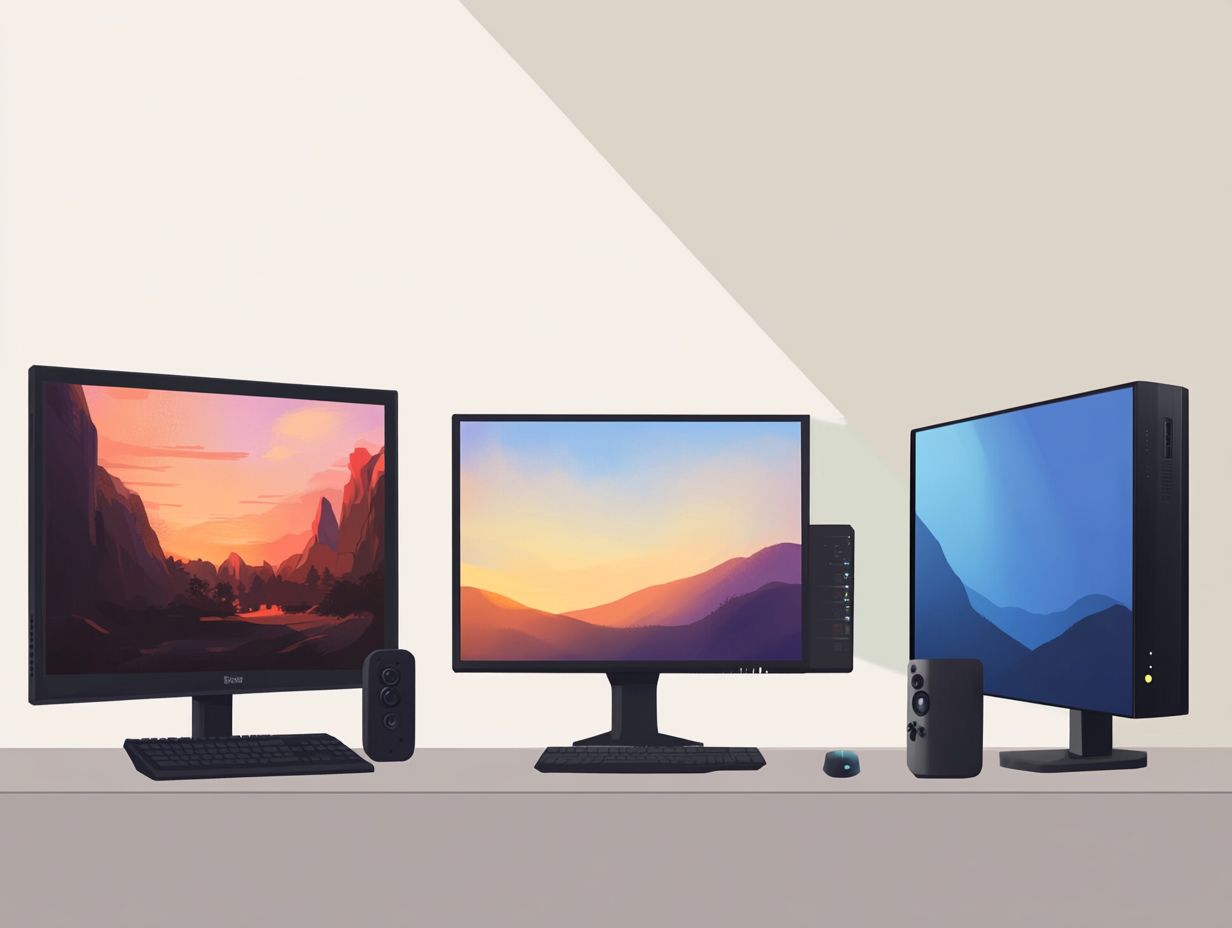
What are the benefits of using a gaming monitor?
Gaming monitors offer higher refresh rates, faster response times, and better color accuracy compared to regular monitors. They provide a more immersive and smooth gaming experience.
What is the ideal size for a gaming monitor?
The ideal size for a gaming monitor depends on personal preference. However, the most common sizes range from 24 to 27 inches. Larger sizes like 32 inches can provide a more immersive experience, but may take up more desk space.
How does the screen resolution affect gaming performance?
A higher screen resolution means more pixels on the screen, resulting in sharper and more detailed images. However, it also requires a more powerful graphics card to handle the increased workload, potentially affecting gaming performance.
What is the difference between a curved and flat gaming monitor?
A curved gaming monitor provides a wider field of view and a more immersive experience, while a flat gaming monitor offers a more traditional viewing experience. Ultimately, it depends on personal preference and the type of games being played.
Don’t miss out on the benefits of gaming monitors! Ready to upgrade your setup? Start optimizing your gaming monitor today!
Can I use a TV as a gaming monitor?
Yes, you can use a TV as a gaming monitor! However, it may not perform as well as a dedicated gaming monitor.
TVs often have higher input lag and slower response times. This can hurt your gaming experience.
What features should I look for in a gaming monitor?
When choosing a gaming monitor, consider screen resolution and refresh rate. It’s also important to look at response time, panel type, and connectivity options.
Finding the right balance of these features is key to enhancing your gaming experience!

